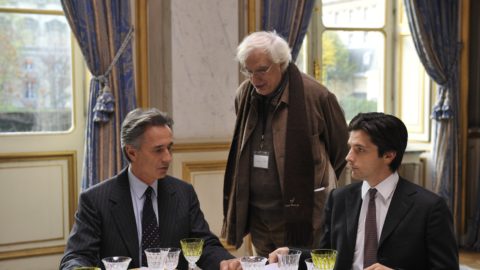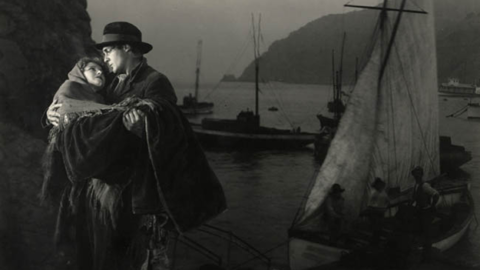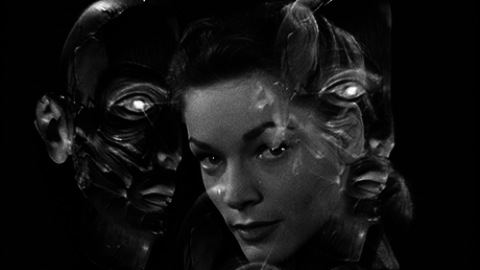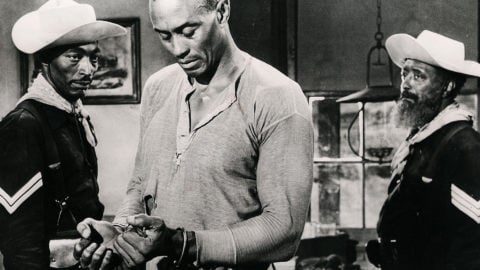Edmond Gréville
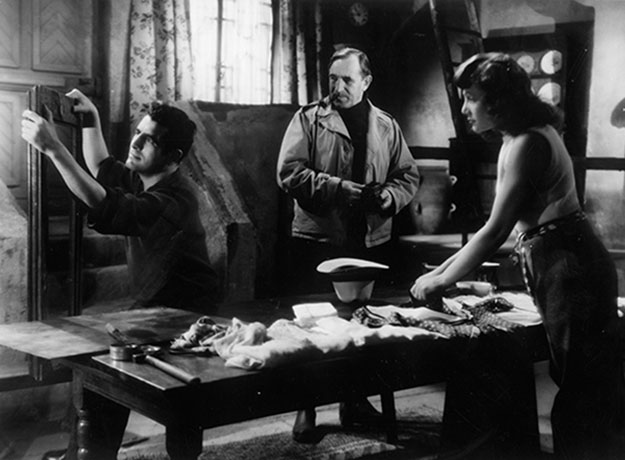
Le Diable souffle
It would be hard to find a more fascinating body of work than Edmond Gréville’s, filmed in both France and Great Britain and utterly foreign to the rules of cinema governing each of these two countries, as well as to the aesthetic revolutions that transformed them. Gréville’s oeuvre is as remote from neorealism and Ealing-style comedy as it is from “poetic realism,” a school prized by film historians despite its incoherence, since it was so often used to categorize directors who have very little in common. Gréville’s oeuvre is as uninfluenced by John Grierson or Free Cinema as it is by Jacques Feyder, Marcel Carné, Julien Duvivier, or the New Wave.
Gréville’s films stand apart from trends of the day, showing an obstinate faithfulness to certain formal principles inherited from the silent era, a period that marks his work indelibly. It is similarly marked by a fascination with Erich von Stroheim and Frank Borzage, an attachment to cosmopolitan novels and adventure stories, and a predilection for solitary heroes of a more or less anarchist bent (of which Charles Vanel in his 1947 Le Diable souffle is the prototype) who confront female spies, femmes fatales, fallen women, ingénues, fleurs bleues (figures of Romantic inspiration), or perverses. Gréville’s works reveal a predilection for lyrical symbolism where one may discover lily ponds worthy of silent films by Cecil B. de Mille and D.W. Griffith as well as Buñuelian lightning strikes. And there’s that statue of the Virgin in Quand sonnera midi (1958) that, decapitated by the burst of a machine gun, falls into a flowerbed, one of the rare splashes of vividness in a dull film; and the face of Stroheim partially hidden by a mask, symbolic of peace and war [in 1940’s Menaces]. Or those unusual and brilliant aesthetic frames in Secret Lives (1937), and the first 10 galvanizing minutes of Brief Ecstasy (1937), a stunning success and one of his most inspired works, along with Noose (1948), Le Diable souffle, Menaces, Pour une nuit d’amour (1947), and Remous (1934).
Gréville’s films were so far on the margins of the system that he often had to make use of artisanal or heterogeneous production methods (cooperatives, eccentric co-productions, secondhand producers). L’Accident (1963), one of his last movies, was even produced by José Bénazéraf, a prolific erotic-film and porn director of the 1960s and 1970s. And one of Gréville’s most ambitious works, Le Diable souffle, was produced by the mysterious company “La France en marche.” This tendency might explain the near-disappearance of a great number of titles, notably Marchand d’amour (1935), which was already a film about cinema and an homage to Stroheim. It opens with a film within a film—and when the audience begins to hiss, the camera pulls back and we realize that we are at the movies, booing the final film made by a Stroheim imitator, played by Jean Galland, who also appears in Remous and Menaces.
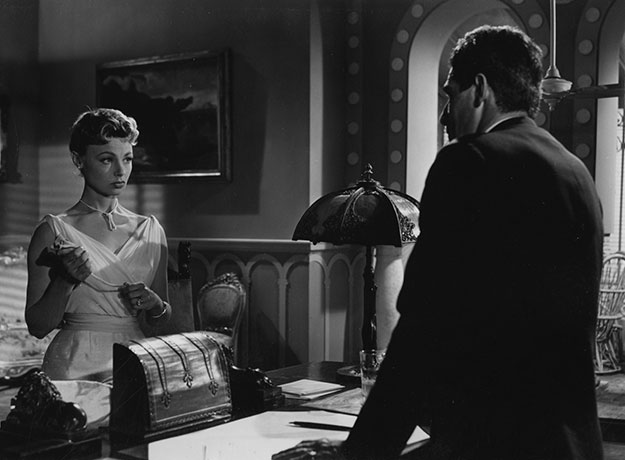
Quand sonnera midi
So deeply marginalized was Gréville’s oeuvre that he died without a penny amid the indifference of the profession. Some friends from the Nickel Odéon, including Bernard Martinand, Yves Martin, and me, even had to take up a collection so that his body would not be thrown into a pauper’s grave, and to pay for a headstone (what happened to it, after all these years?) in the Cagnes cemetery, where he had shot so many of his films. A reporter from Le Figaro’s literary supplement, shocked by this injustice, wrote an article that received only one response: a pained, friendly, and warm letter (and check) from René Clair, who recalled that Gréville had played the friend of the protagonist, a very important role in his 1930 film Sous les toits de Paris.
Several decades later, Gréville’s work still remains underrecognized. The Cinémathèque did rediscover the bizarre and literally incredible Le Train des suicidés, a film that Gréville was able to make because a producer wanted to unload stock footage of railway maps, train tracks, and trains. The Cinémathèque has also restored the gripping and original Remous, one of the first films (perhaps the very first) to take on the theme of sexual impotence, doing so with compassion and great lyricism and avoiding voyeurism or sniggering. Yet in France, despite restorations by the British Film Institute and the efforts of William K. Everson, we remain regrettably ignorant of Gréville’s British period, even though it contains some of his clearest successes. Everson made himself a passionate advocate of Brief Ecstasy, a film that, when it premiered, unleashed the enthusiasm of Graham Greene:
…the story is of the struggle between tenderness and desire. With so bare a plot Mr. Greville has time to dwell on everything other directors cut: the ‘still-lifes’ […]. Other directors have to ‘get on with the story.’ Mr. Greville knows that the story doesn’t matter; it’s the atmosphere which counts, and the atmosphere—of starved sexuality—is wantonly and vividly conveyed. Mr. Greville learnt in France how to photograph a woman’s body—uncompromisingly: every close-up of Miss Linda Travers drives the sexuality home: a leg in the library, buttocks over the billiard table.
I have quoted this hard-hitting and incisive critique at length because it can be applied to all of Gréville’s oeuvre, starting with titles such as Remous, Pour une nuit d’amour, Le Diable souffle, and L’île du bout du monde (1959). His other English films are no less exciting, whether it be Secret Lives (1939)—a dazzling exercise in staging that, through the angle of an unacknowledged remake of Josef von Sternberg’s Dishonored, pays affectionate and spectacular homage to Sternbergian formalism—or, above all, Noose (1948), a breathless film noir demonstrating remarkable visual control. Noose is representative of Gréville’s highly individual talent, and one can compare his depiction of Soho with that of Jules Dassin’s Night and the City, made two years later: the same trafficking, the same swindles that end in violence and crime. Noose’s Joseph Calleia could almost be the Italian cousin of Night and the City’s Herbert Lom (he’s Maltese), and the world of wrestling that Night and the City depicts recalls the boxers in Noose.
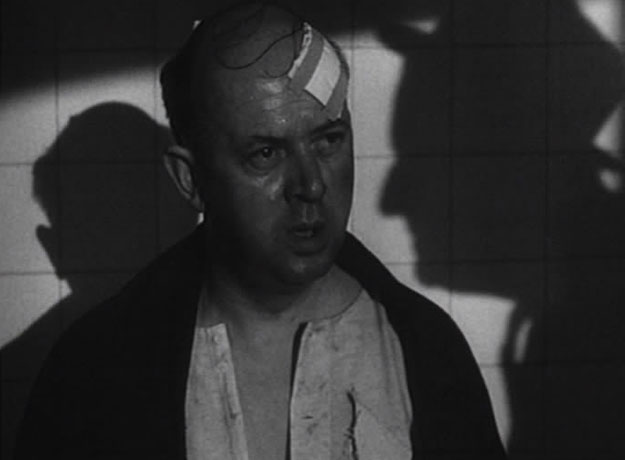
Noose
The comparison stops there, because [in Noose] Gréville sometimes opts for a strangely light tone (the extraordinarily well-photographed Carole Landis is continually losing her shoes) that breaks the continuity of the suspense, as do the gags (some more successful than others) and a style of acting that is occasionally spectacularly theatrical (Calleia, who mugs it up, is fantastic, and Nigel Patrick, extraordinary, steals the film). There are also admirably composed scenes of violence (like the murder of a young woman in a boxing ring), visual surprises, brilliant ellipses, audacious framing (Calleia’s Sugiani speaking to the terrible barber who acts as his executioner in a stairwell; the moment Ruth Nixon’s Annie realizes her life is in danger, she is filmed in a low-angle shot while above her we see polished windowpanes—framing that evokes Michael Powell and Emeric Pressburger’s The Small Back Room).
Yet what moves me most are the background scenes depicting young women, like the seemingly useless moment when beautiful Annie enters the nightclub while Olive Lucius sings a song in French: a young girl puts on makeup, waiters rest, a cleaning woman sweeps the floor, and a murder is about to take place, which Gréville conveys through the image of a stole that slips to the ground. British puritanism and Anglo-Saxon understatement seem to electrify Gréville and make his energy feverish. The English language provides him more rigor and enables him to avoid his guilty pleasure, that immoderate taste for visual and linguistic puns that sometimes handicap his French film scripts, particularly in later years. One should very much see But Not in Vain (1948). But it’s best to forget the mediocre Beat Girl (1960) despite the music by John Barry
The sheer pleasure in filming that can be found in just about all of Gréville’s works touched me at the time and still moves me today: fleetingly present in commissions (Le port du désir, 1954, deceptively present, and containing a beautiful underwater sequence, in Dorothée cherche l’amour, 1945, which also has a very well-directed gunfight); and sustained throughout his best works (Secret Lives, Noose, Pour une nuit d’amour, Le Diable souffle, Remous, Brief Ecstasy, parts of L’Envers du paradis, 1953, and L’Accident). This joy in filming bears no relationship to the visual brio of a Duvivier, the dazzling rigor of a Jean Grémillon or a Max Ophüls. It privileges surprise, the pileup of ideas, the flow of images that recalls wordplay, without ever being in danger of excess or ridicule. Gréville doesn’t recoil from special effects, doesn’t hesitate to divide the screen in two like a checkerboard in which the heads of his characters are inlaid, or set doves into flight above the Panthéon (in Menaces), and this audacity often pays off, even if it may make proponents of the sober and the natural smile.
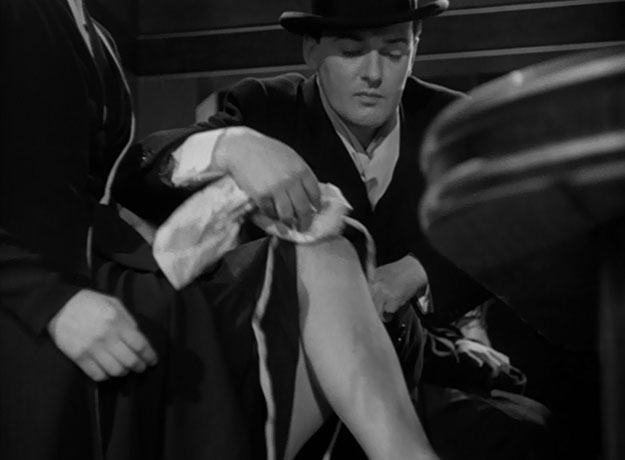
Brief Ecstasy
Gréville’s writing aims at the ludic, the poetic. It rejects and contradicts the requirements and diktats of realism (neo- or otherwise) and naturalism, and proceeds by ruptures, whether rhythmic, formal, or associative. For example, in Remous, after an accident, a panning shot upward toward the clouds is juxtaposed with a close-up of big packet of absorbent cotton being carried by a nurse. In Noose, an urban landscape is succeeded by a propaganda poster reflected in a pool of water just before the image is broken up by the step of a passerby who brings us with him to a church, from which we see a priest is leaving, the vicar of Soho. Elaborate formal compositions and unexpected camera movements incessantly break up the arrangement of a scene—and consequently the plot—continually destabilizing the narrative logic. And in Le Diable souffle, Charles Vanel’s character awaits the results of an operation. Suddenly, right in front of him, he sees the surgeon burst out laughing while announcing to him that he’s not a doctor. This isn’t an unexpected nightmare (as in Arthur Ripley’s The Chase) and it will turn out to be groundless, but the effect is spectacular. It is non sequitur cinema, as Gérard Legrand rightly notes, despite some strong instances of beautifully sketched lyrical flows, or moments of psychological counterpoint (Remous). Discontinuity is accepted as such, often for economic reasons but also as the projection of a kaleidoscopic mentality that Gréville assumes in more than one film.
He also fragments his scripts, shattering them with repeated changeups of tone and rhythm, accumulating strange warps and notations in a loose fabric. Menaces is revelatory and literally changes its style according to the perspective of its characters: American lyricism with Denise (Mireille Balin, who inspired the most beautiful moment of the film: that traveling shot on her face when, shut in a telephone booth, we see her talking without being able to hear her); expressionistic and restrained with Stroheim’s Professor Hoffman; pleonastic with Louis (Jean Galland, who overacts this nonetheless golden scene); a very prewar French cinema style with Paul Demange’s servant; and astonishingly exact and delicate with Madeleine Lambert’s hotel patron.
Gréville’s mise en scène sometimes progresses in a rapid, elliptical fashion. Few prewar films have treated the drama of falling in love at first sight in such a fast and brutal manner as Brief Ecstasy. A man and a woman meet. In just a few frames, we find them in a hotel room. The entire beginning and several flashbacks in Les Menteurs (1961), as well as the murder in Pour une nuit d’amour (featuring very beautiful music by Jean Wiener), have the same speed, the same desire to make the plot disappear behind signs and more or less symbolic reference points. On other occasions, these narrative ruptures sometimes bear witness to a casualness that is a little too obvious—an attempt to camouflage a lack of money, the refusal to take himself seriously, or an attachment to contradictions—which breaks up the dramatic tension.
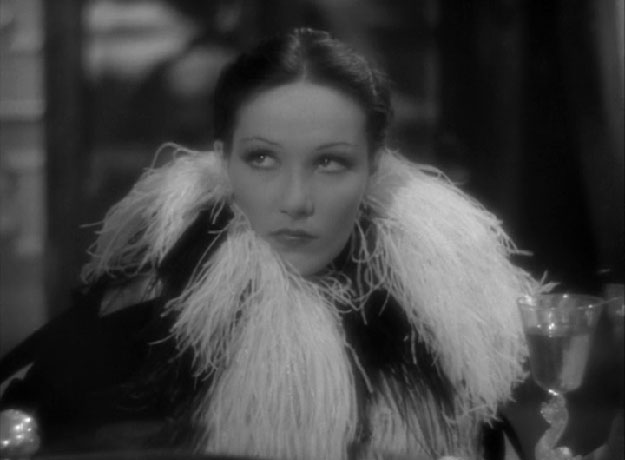
Secret Lives
Gréville’s pleasure in filming is never more evident than when he depicts female characters, whom he always approaches lovingly, even in the case of the fragile and perverse murderer in Pour une nuit d’amour, so well acted by Odette Joyeux. This “respectable erotomania,” as he liked to call it, was scattered throughout his work in fetishistic images (that foot that gets kissed in L’Envers du paradis, or, in the same film, Etchika Choureau giving her mirror image a big kiss) or sexual symbols (L’île du bout du monde—that naïve and sadly far too heavy condensation of Grevillean obsessions that have not aged well, unlike Le diable souffle or Noose). His female protagonists strike a balance between agitation and play, to quote Gainsbourg, and he amuses himself by making their hearts bleed and burst aflame. Facing these women, the men in his films often seem colorless, uncertain, nitwitted. His most fully realized protagonist (aside from the characters played by Stroheim, such as the armchair sailor who wanted so badly to be a Christmas tree in L’Envers du paradis) remains Julien in Pour une nuit d’amour—with Roger Blin a bold and exciting casting choice (much like Héléna Bossis playing Sartre in Le Diable souffle). The sacrifice of Blin’s character becomes a true social provocation, and here and in Secret Lives, Gréville best concretizes his libertarian and anarchist options.
Sexual desire is the engine of the majority of his films. As we are told in a fake proverb cited in Le Diable souffle: “Women are made from fire, men are made from oakum, and the devil blows on them.” Through desire and its repression, the subjects in Remous, Brief Ecstasy, and Pour une nuit d’amour articulate themselves, as is the case in all these films that are full of characters who spy and moments of voyeurism (Jean Servais’s Paul keeping surveillance over Dawn Addams’s Norma in Les Menteurs; Mireille Balin’s Denise discovering that Jean Galland’s Louis’s room is covered with photographs and portraits of her in Menaces). Yet this sexuality is never exempt from tenderness, above all in the later films, and Gréville knows how to draw forth unexpected surges of warmth from poorly used actresses such as Dawn Addams or unsensual ones like Dany Robin, the sight of whom suddenly calls to mind a line of poetry by Pierre Jean Jouve—“the exquisite charity of her hair”—and to whom one wishes to say, like Patrice de la Tour du Pin, “I will enlarge your heart so that it can contain all my love.”
Bertrand Tavernier last wrote about Delmer Daves for Film Comment. His film, My Journey Through French Cinema, opens on June 23.



